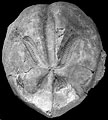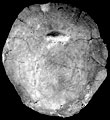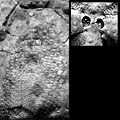The Echinoid Directory
Contributed by Dinesh Srivastava, January 2010
Hypselaster rajasthanensis Srivastava and Kulshreshtha 2009, p. 229
| Distribution | Lower Eocene (Khuiala Formation), Rajasthan, India. |
|---|---|
| Type | Holotype - GSI Type No. 21442; Paratype - GSI Type No. 21443. Curatorial Division, Geological Survey of India, Kolkata, India. |
| Classification and/or Status | Order Spatangoida; Family Schizasteridae A species of Hypselaster Clark, 1917 |
| Remarks | The Rajasthan specimens are comparable with Schizaster alveolatus Duncan & Sladen, described from the Eocene sediments of Sind, Pakistan (Duncan & Sladen, 1882-1886). However, that species has a deep frontal sinus and the details of its apical system are lost. The specimens of Rajasthan differ from Ditremaster Munier-Chalmas, 1885 in not having sub-globular and small test. H. rajasthanensis is close to the H. obliquatus (Sowerby) from the Eocene of Babia Hill, Kachchh, India (Grant, 1840) but differs in not having a central apical system and circular test. It also differs from H. perplexus Arnold & Clark described from the Eocene sediments of Jamaica (Arnold & Clark, 1927) in having sunken petals which do not reach the ambitus. Arnold, B. W. & Clark, H. L. 1927. Jamaican fossil echini. With descriptions of new species of Cainozoic echinoidea by Herbert L. Hawkins. Memoirs of the Museum of Comparative Zoology at Harvard College, 50(1): 1-84, 22 pls, 3 figs., Duncan, P. M. & Sladen, W. P. 1882 - 1886. Fossil Echinoidea of Western Sind and the Coast of Baluchistan and of the Persian Gulf, from Tertiary formations. Palaeontologia Indica, Series 14, 1(3): 87, Pl. 20, figs. 10-14. Grant, C. W. 1840. Memoir to illustrate a geological map of Kutch, geological papers on western India including Cutch, Sinde with an atlas of maps and plates. Transactions Geological Society of London, 5(2): 289 - 326. Srivastava, D. K. & Kulshreshtha, S. K., 2009. A new record of a Schizasterid (Echinodea) from the Khuiala Formation, Jaisalmer District, Rajasthan, India. Journal of the Palaentological Society of India, 54(2), 229-232. |


